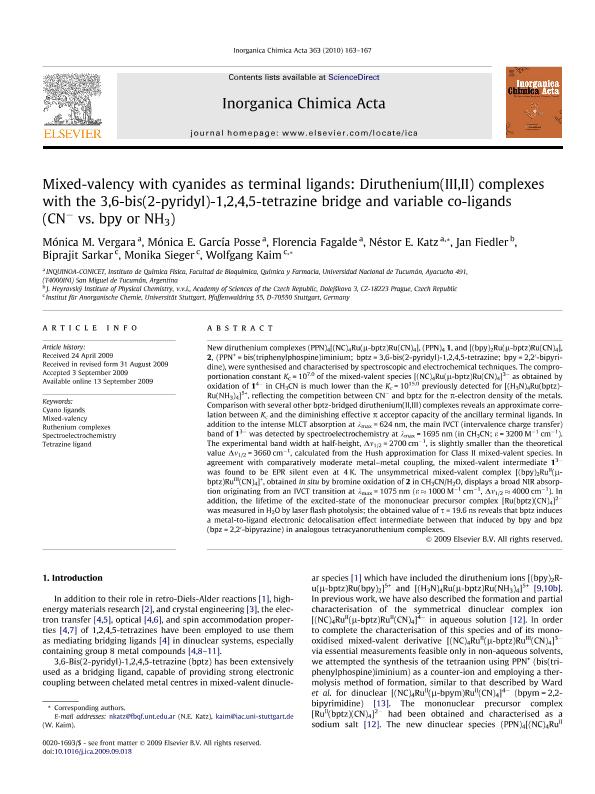Mostrar el registro sencillo del ítem
dc.contributor.author
Vergara, Monica Mercedes

dc.contributor.author
García Posse, Mónica Ema

dc.contributor.author
Fagalde, Florencia

dc.contributor.author
Katz, Néstor Eduardo

dc.contributor.author
Fiedler, Jan
dc.contributor.author
Sarkar, Biprajit
dc.contributor.author
Sieger, Sabine
dc.contributor.author
Kaim, Wolfgang
dc.date.available
2018-07-23T20:28:35Z
dc.date.issued
2010-01
dc.identifier.citation
Vergara, Monica Mercedes; García Posse, Mónica Ema; Fagalde, Florencia; Katz, Néstor Eduardo; Fiedler, Jan; et al.; Mixed-valency with cyanides as terminal ligands: Diruthenium(III,II) complexes with the 3,6-bis(2-pyridyl)-1,2,4,5-tetrazine bridge and variable co-ligands (CN- vs. bpy or NH3); Elsevier Science Sa; Inorganica Chimica Acta; 363; 1; 1-2010; 163-167
dc.identifier.issn
0020-1693
dc.identifier.uri
http://hdl.handle.net/11336/52922
dc.description.abstract
New diruthenium complexes (PPN)4[(NC)4Ru(μ-bptz)Ru(CN)4], (PPN)4 1, and [(bpy)2Ru(μ-bptz)Ru(CN)4], 2, (PPN+ = bis(triphenylphospine)iminium; bptz = 3,6-bis(2-pyridyl)-1,2,4,5-tetrazine; bpy = 2,2′-bipyridine), were synthesised and characterised by spectroscopic and electrochemical techniques. The comproportionation constant Kc = 107.0 of the mixed-valent species [(NC)4Ru(μ-bptz)Ru(CN)4]3- as obtained by oxidation of 14- in CH3CN is much lower than the Kc = 1015.0 previously detected for [(H3N)4Ru(bptz)Ru(NH3)4]5+, reflecting the competition between CN- and bptz for the π-electron density of the metals. Comparison with several other bptz-bridged diruthenium(II,III) complexes reveals an approximate correlation between Kc and the diminishing effective π acceptor capacity of the ancillary terminal ligands. In addition to the intense MLCT absorption at λmax = 624 nm, the main IVCT (intervalence charge transfer) band of 13- was detected by spectroelectrochemistry at λmax = 1695 nm (in CH3CN; ε = 3200 M-1 cm-1). The experimental band width at half-height, Δν1/2 = 2700 cm-1, is slightly smaller than the theoretical value Δν1/2 = 3660 cm-1, calculated from the Hush approximation for Class II mixed-valent species. In agreement with comparatively moderate metal-metal coupling, the mixed-valent intermediate 13- was found to be EPR silent even at 4 K. The unsymmetrical mixed-valent complex [(bpy)2RuII(μ-bptz)RuIII(CN)4]+, obtained in situ by bromine oxidation of 2 in CH3CN/H2O, displays a broad NIR absorption originating from an IVCT transition at λmax = 1075 nm (ε ≈ 1000 M-1 cm-1, Δν1/2 ≈ 4000 cm-1). In addition, the lifetime of the excited-state of the mononuclear precursor complex [Ru(bptz)(CN)4]2- was measured in H2O by laser flash photolysis; the obtained value of τ = 19.6 ns reveals that bptz induces a metal-to-ligand electronic delocalisation effect intermediate between that induced by bpy and bpz (bpz = 2,2′-bipyrazine) in analogous tetracyanoruthenium complexes.
dc.format
application/pdf
dc.language.iso
eng
dc.publisher
Elsevier Science Sa

dc.rights
info:eu-repo/semantics/openAccess
dc.rights.uri
https://creativecommons.org/licenses/by-nc-sa/2.5/ar/
dc.subject
Cyano Ligands
dc.subject
Mixed-Valency
dc.subject
Ruthenium Complexes
dc.subject
Spectroelectrochemistry
dc.subject
Tetrazine Ligand
dc.subject.classification
Otras Ciencias Químicas

dc.subject.classification
Ciencias Químicas

dc.subject.classification
CIENCIAS NATURALES Y EXACTAS

dc.title
Mixed-valency with cyanides as terminal ligands: Diruthenium(III,II) complexes with the 3,6-bis(2-pyridyl)-1,2,4,5-tetrazine bridge and variable co-ligands (CN- vs. bpy or NH3)
dc.type
info:eu-repo/semantics/article
dc.type
info:ar-repo/semantics/artículo
dc.type
info:eu-repo/semantics/publishedVersion
dc.date.updated
2018-07-23T13:51:20Z
dc.journal.volume
363
dc.journal.number
1
dc.journal.pagination
163-167
dc.journal.pais
Países Bajos

dc.journal.ciudad
Amsterdam
dc.description.fil
Fil: Vergara, Monica Mercedes. Consejo Nacional de Investigaciones Científicas y Técnicas. Centro Científico Tecnológico Conicet - Tucumán. Instituto de Química del Noroeste. Universidad Nacional de Tucumán. Facultad de Bioquímica, Química y Farmacia. Instituto de Química del Noroeste; Argentina
dc.description.fil
Fil: García Posse, Mónica Ema. Consejo Nacional de Investigaciones Científicas y Técnicas. Centro Científico Tecnológico Conicet - Tucumán. Instituto de Química del Noroeste. Universidad Nacional de Tucumán. Facultad de Bioquímica, Química y Farmacia. Instituto de Química del Noroeste; Argentina
dc.description.fil
Fil: Fagalde, Florencia. Consejo Nacional de Investigaciones Científicas y Técnicas. Centro Científico Tecnológico Conicet - Tucumán. Instituto de Química del Noroeste. Universidad Nacional de Tucumán. Facultad de Bioquímica, Química y Farmacia. Instituto de Química del Noroeste; Argentina
dc.description.fil
Fil: Katz, Néstor Eduardo. Consejo Nacional de Investigaciones Científicas y Técnicas. Centro Científico Tecnológico Conicet - Tucumán. Instituto de Química del Noroeste. Universidad Nacional de Tucumán. Facultad de Bioquímica, Química y Farmacia. Instituto de Química del Noroeste; Argentina
dc.description.fil
Fil: Fiedler, Jan. Academy of Sciences of the Czech Republic; República Checa
dc.description.fil
Fil: Sarkar, Biprajit. Universität Stuttgart; Alemania
dc.description.fil
Fil: Sieger, Sabine. Universität Stuttgart; Alemania
dc.description.fil
Fil: Kaim, Wolfgang. Universität Stuttgart; Alemania
dc.journal.title
Inorganica Chimica Acta

dc.relation.alternativeid
info:eu-repo/semantics/altIdentifier/doi/https://dx.doi.org/10.1016/j.ica.2009.09.018
dc.relation.alternativeid
info:eu-repo/semantics/altIdentifier/url/https://www.sciencedirect.com/science/article/pii/S0020169309005441
Archivos asociados
